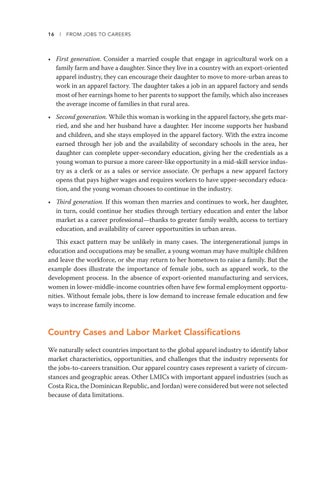16
l
FROM JOBS TO CAREERS
• First generation. Consider a married couple that engage in agricultural work on a family farm and have a daughter. Since they live in a country with an export-oriented apparel industry, they can encourage their daughter to move to more-urban areas to work in an apparel factory. The daughter takes a job in an apparel factory and sends most of her earnings home to her parents to support the family, which also increases the average income of families in that rural area. • Second generation. While this woman is working in the apparel factory, she gets married, and she and her husband have a daughter. Her income supports her husband and children, and she stays employed in the apparel factory. With the extra income earned through her job and the availability of secondary schools in the area, her daughter can complete upper-secondary education, giving her the credentials as a young woman to pursue a more career-like opportunity in a mid-skill service industry as a clerk or as a sales or service associate. Or perhaps a new apparel factory opens that pays higher wages and requires workers to have upper-secondary education, and the young woman chooses to continue in the industry. • Third generation. If this woman then marries and continues to work, her daughter, in turn, could continue her studies through tertiary education and enter the labor market as a career professional—thanks to greater family wealth, access to tertiary education, and availability of career opportunities in urban areas. This exact pattern may be unlikely in many cases. The intergenerational jumps in education and occupations may be smaller, a young woman may have multiple children and leave the workforce, or she may return to her hometown to raise a family. But the example does illustrate the importance of female jobs, such as apparel work, to the development process. In the absence of export-oriented manufacturing and services, women in lower-middle-income countries often have few formal employment opportunities. Without female jobs, there is low demand to increase female education and few ways to increase family income.
Country Cases and Labor Market Classifications We naturally select countries important to the global apparel industry to identify labor market characteristics, opportunities, and challenges that the industry represents for the jobs-to-careers transition. Our apparel country cases represent a variety of circumstances and geographic areas. Other LMICs with important apparel industries (such as Costa Rica, the Dominican Republic, and Jordan) were considered but were not selected because of data limitations.


